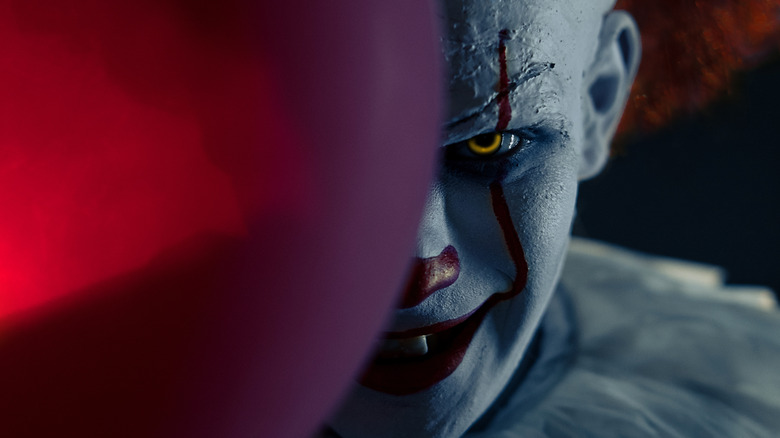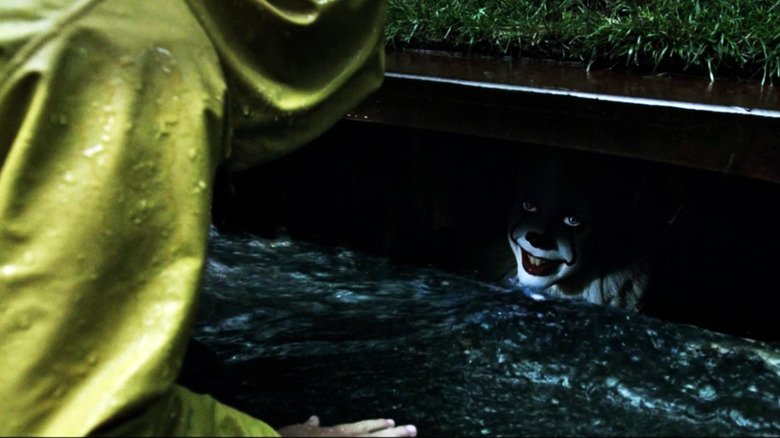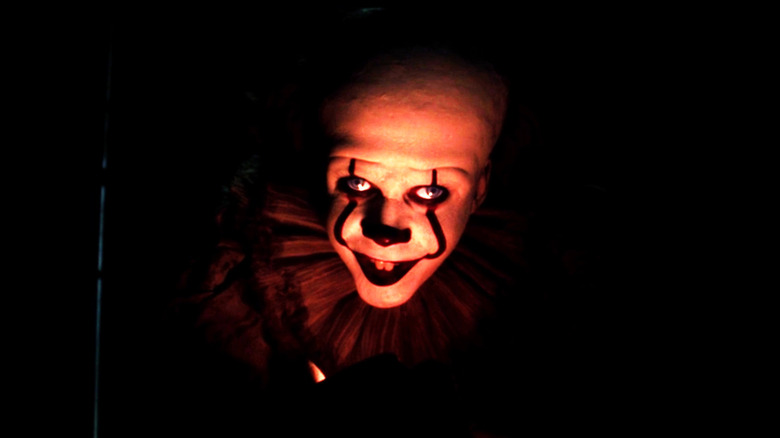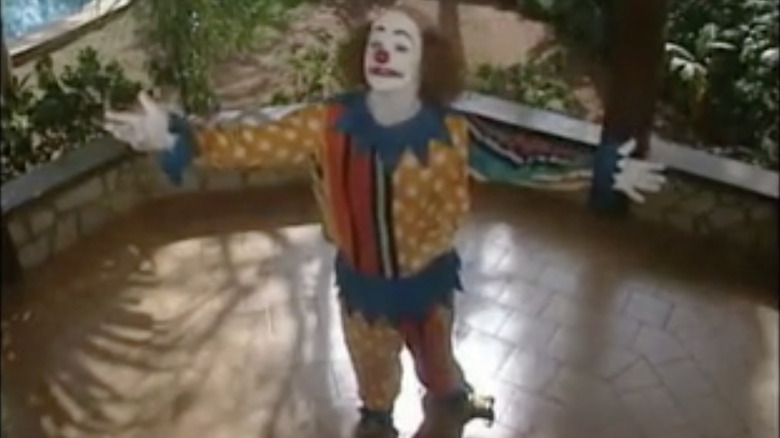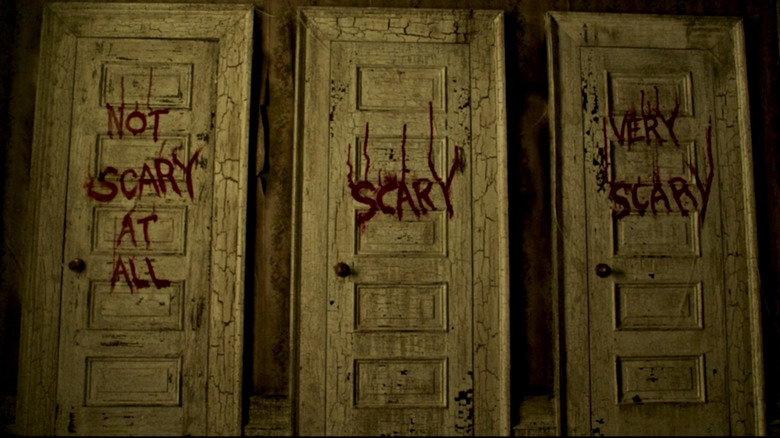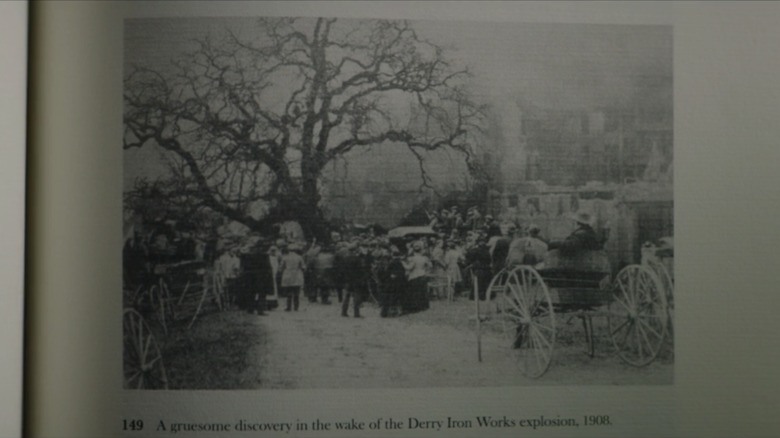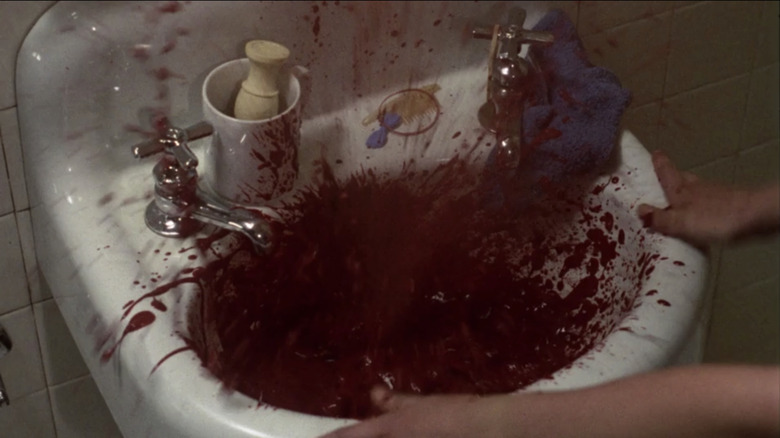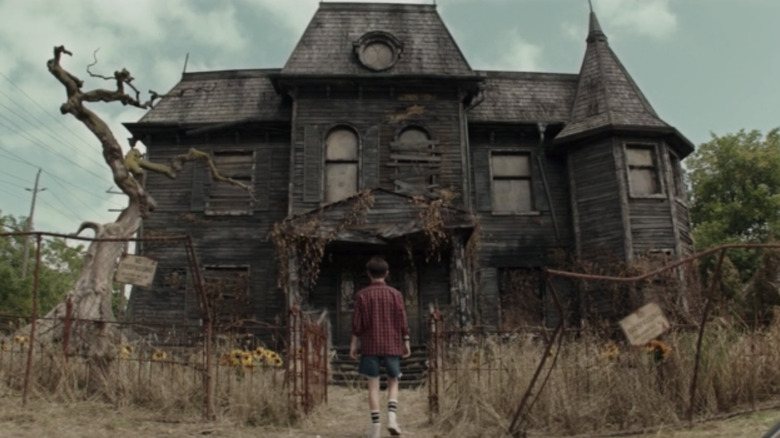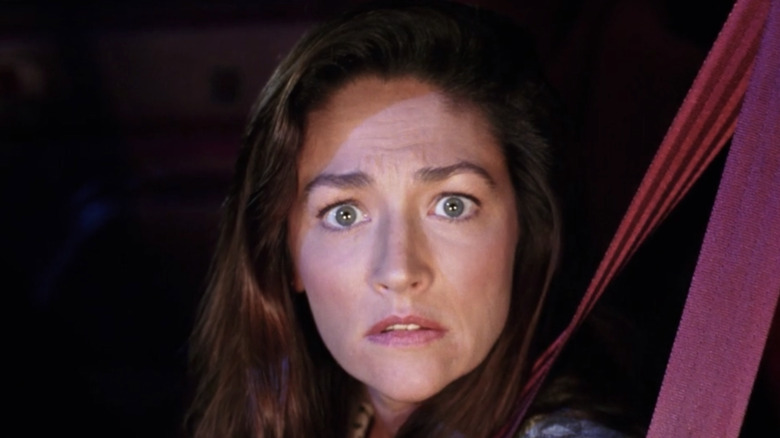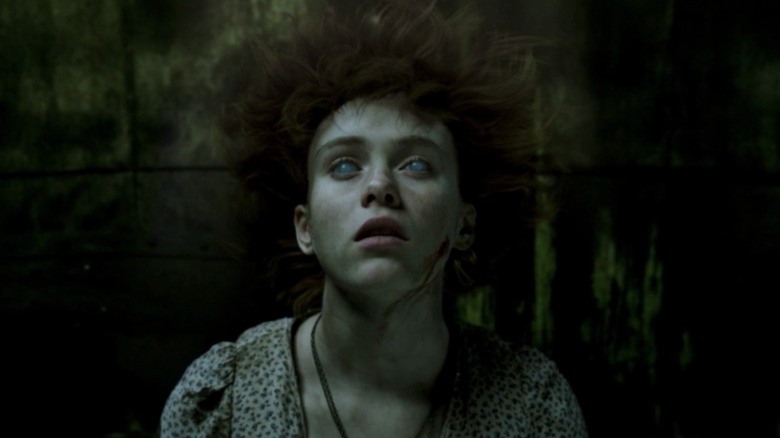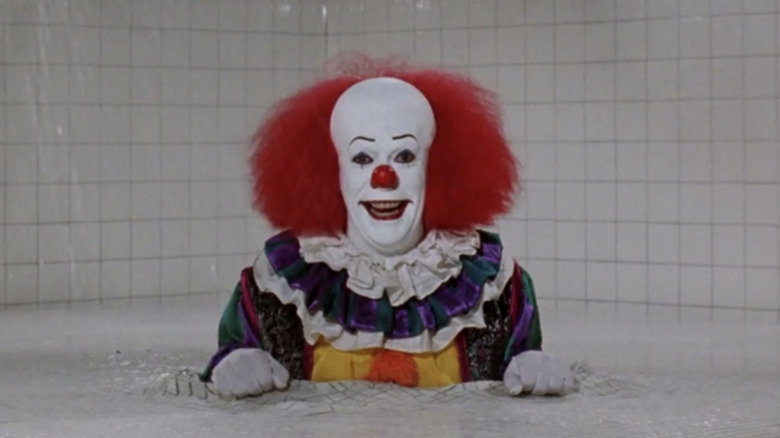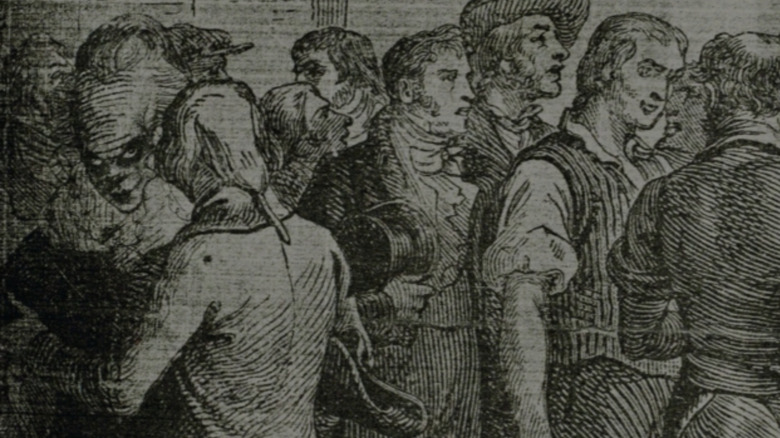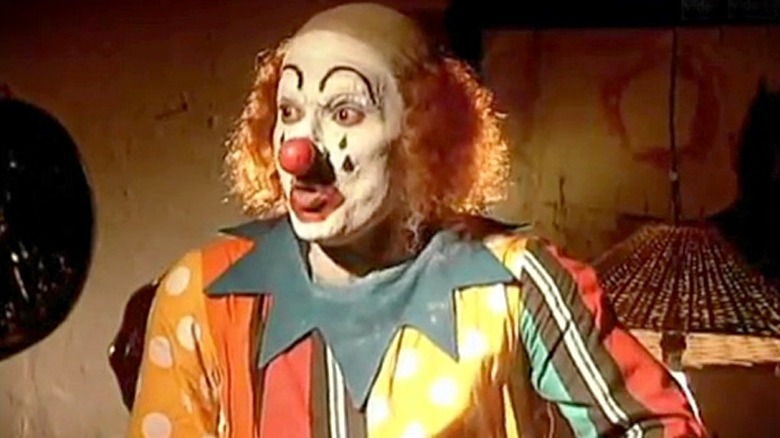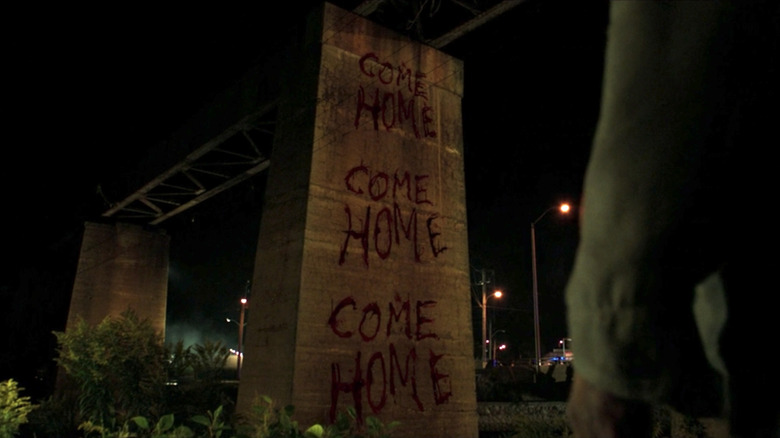The Worst Decisions Pennywise Made In The It Franchise
Stephen King's horror novel "It" has been widely considered a classic since its initial release in 1986. Since then it has been officially adapted three times, starting in 1990 with the infamous ABC miniseries starring Tim Curry in an iconic performance that King himself claims deserves much of the credit for the success of the recent films. There was also Zee TV's "Woh" in 1998 which, despite not achieving international success, was ranked by the India Times among the top 8 scariest television shows. And most recently, Pennywise the Dancing Clown has floated onto the silver screen with the adaptations "It" and "It Chapter Two."
"It" focuses on a group of seven friends known as The Losers as they battle the evil force that is Pennywise the Dancing Clown. Depictions of Its behavior vary in both tactics and intensity from property to property, taking the book's described opportunistic apex predator and transforming it into a vengeful spirit and the realization of every child's nightmares.
Some of these choices work, some don't, and some of them are so baffling they might lead one to question how capable a predator Pennywise truly is. With a prequel series by the creative team of the most recent "It" adaptation on the horizon, it's a good time to look back on some of those errors to prepare ourselves for the horrors that are yet to come.
Prey Selection
In the 2017 film, Pennywise attempts to get to know its victims so that it can entice them into the dark corners of Derry. While this could be an excellent method to identify vulnerable prey and avoid those who might pose a threat to its secrecy, it does not seem to think that far ahead. Instead of focusing on loners, it stalks individuals regardless of risk and without any attempt at covering its tracks. For example, in an exchange that features several subtle differences from the book, it chooses to eat Georgie despite his stated close relationship with his family. Of course, Georgie is immediately missed and faithfully sought by the older brother who would ultimately kill Pennywise 28 years later. If it were the feral, opportunistic creature described in the book, this might make sense, but for a seemingly tactical entity, this seems to be a foolish decision.
Pennywise is described in the text of "It" as a "creature which would eat anything but which was especially hungry for boymeat," meaning that Its diet is not limited. Despite this, the entity chooses to almost exclusively hunt human children. The explanation in the novel is that children's fears are stronger and easier for it to utilize, and it loves its food seasoned by fear. But if that's the only motivation, it would seem more tactical to hunt animals with even simpler fears and a much lower likelihood of being reported missing or avenged by traumatized siblings.
An Outdated Aesthetic
Pennywise's need for an updated primary form becomes immediately clear in "It Chapter Two" when it nearly misses out on its second victim, a child who is not at all enticed by the clown's appearance. Pennywise is able to turn the tables back in its favor with a little not-so-subtle gaslighting, but it's a close call. In the text, it is established that the clown visage is its non-threatening default setting, utilized only when it knows it will be able to convince its prey to accept their doom without the effort involved in specifically terrorizing them. Sure, the harlequin look might've worked to placate kids back in the day, but modern children aren't so easy to impress.
Additionally, within the lore of the films, Pennywise's singular weakness is that it can be overcome by bullying. It is essentially weak to embarrassment, and yet it has chosen to dress itself as a fool. Paired with the fact that it so regularly goes after teenagers, it's rather surprising none of them has gotten a good laugh in at its antiquated threads and accidentally bested The Derry Disease. It may have served the clown better if he had received an updated 21st-century form along with all the other changes made to the story, if only for its own protection.
Lengthy Monologues
Much like a Bond villain, the titular Woh of Zee TV's adaptation is remarkably fond of the extended monologue. Woh loves to pop up and taunt the various members of the Lucky Seven, but very rarely poses any kind of mortal threat. He shows up early in the hopes of scaring adult Ashutosh (Panchgani's equivalent to Mike) off of his trail, which serves enough of a purpose to be understandable. However, in most of his subsequent appearances, Woh seems to largely be enjoying the sound of his own voice, choosing to spend minutes at a time dramatically rambling threats and vague context for his ghostly motivations when he could instead be relocating his victims, as he supposedly wants to do.
Even when monologues turn to enticement, the joker is very easily dissuaded by a simple "no," which sends the clown into a sort of toddler-like tantrum. After spiriting away Rahul's little brother Rohit, he makes an attempt to capture Rahul with the character's typical promise of floating. Rahul says no, and the enraged Woh chooses to simply continue his monologue before vanishing harmlessly into thin air.
The Scary Doors
The Pennywise of the film adaptations has an awful lot of self-confidence. Not only is it gutsy enough to bring the Losers back intentionally, it's so confident in its own trickery that it has the audacity to repeat its own greatest hits. The "scary doors" trick — wherein a path is blocked off by three doors with differing descriptions of their scariness written in blood — is brought back twice. Whether Pennywise thought this trick — played specifically on Richie both times — was particularly effective, or if it simply found it amusing, is unclear. Yet, despite the gang having almost immediately seen through the illusion the first time by simply looking behind their chosen door a second time, it brings the trick back again 27 years later.
Worse than that, the second appearance of the puzzle is handled clumsily, as if it had only been brought back in order to prove a point. After Richie and Eddie are inconvenienced by the delay for a short while, they decide to just take an alternate route. They are allowed to run away without any repercussions, despite skipping the challenge while actively being pursued. Pennywise does not appear to get anything from this exchange, especially considering the fact that it could simply have eaten them once it had them cornered.
Getting Personal
All the iterations of "It" feature the fairly consistent concept of a monster that wakes up roughly every 27 years to feed, wreak mayhem, and generally make life in Derry unpleasant for everyone. Mass death events happen regularly in 27-year intervals from the beginning of the area's recorded history, involving everything from the Roanoke-like disappearance of the town's original settlers to tragedies such as the Easter explosion at the Kitchener Ironworks, which killed 102 people. Since none of these events seem to be noted as suspicious in the town's records, it's safe to say that this hunting tactic worked well for Pennywise during the roughly 2,000,000 years it resided beneath present-day Derry.
Despite the centuries of success when It is encountered for the first time within the plot It has begun hunting children individually, seemingly abandoning its previous methodology in favor of personalizing each encounter for a single individual. With this updated approach, Pennywise mostly just manages to increase how many people see it and remember it long-term.
"So why switch tactics?" one might ask. There is not an answer readily available in the text or any of the adaptations thus far. Still, maybe this will be addressed in the upcoming prequel series which promises to offer some background for the dancing clown. For the time being, though, this remains an odd tactical decision on the part of the Eater of Worlds.
Messing with the Plumbing
The novel provides ample details about the layout of Derry and the Losers' most visited locations. An area referred to as "the Barrens" occupies the most prominent role as it houses the location of the Losers' underground hideout along with several of the major sewer access points which are used as both entrances and exits to the drainage tunnels that serve as Pennywise's lair.
While it is noted that by 1984, the portion of the sewer containing Pennywise's nest had become unused due to changes made in waste management after the creation of the EPA, this section of tunnel was still in use during the Losers' adventures in 1958. The nearby low-income neighborhood of Old Cape is described as having drainage so bad "that there were stories of toilets and sewer-pipes actually exploding." Since Pennywise is extremely weakened in its sleeping state, risking the location of its nest with this carelessness put it severely at risk. It's a miracle, really, that no wandering city maintenance worker happened upon its piles of bones and dealt with Pennywise accordingly, however anticlimactic that may have been.
Keeping House
The house on Neibolt Street is a feature that — while not exclusive to the films — serves a much more significant role in them than it does anywhere else. It is the Losers' first big lead towards finding and killing Pennywise after identifying it as standing over the original well of Derry. This ramshackle building has everything you want from a neighborhood haunted house from the dilapidated all-black gothic exterior to the creepy, dust-coated interior. While DIY might not be Pennywise's strong suit, taking any amount of time to put effort into camouflaging its primary haunt would likely have been in its favor. Naturally, when the kids find out there is a chance that a major sewer entrance still remains beneath the creepiest house in town they don't even question it, they just gear up.
Not only is it living underneath an obviously otherworldly house, but once they get down into its lair, they discover that it has left tools and weapons lying around, as if inviting any of its prey to go after it as soon as its back is turned. Which, since it has a habit of leaving people alone while they investigate its nest, is likely a lapse in judgment. The mess ultimately leads to its defeat in round one, something that could have been avoided if it had only taken the time to pick up all that loose rebar.
Taking Audra
Bill's wife — often referred to as simply "the writer's woman" in the book — was largely cut from the film adaptations, but she serves a significant role as Beverly's foil in both the book and, to a lesser extent, the miniseries. Audra follows Bill to Derry, arriving not long before the group's final assault on the underground lair. In the 1990 adaptation, she is almost immediately captured by It, who calls her by name, making it clear that it knows who she is. After exposing her to its inner form referred to as "Deadlights," her mind is overwhelmed and forced into a catatonic state allowing It to easily transport her back to its lair. The book fills in more details, showing It preparing her as a stored food source while in its massive spider form.
While this move might make sense if It was looking to use Audra as bait for Bill, he was in no way aware that Audra had arrived in town and was already on his way to the sewers. He did not require bait to be drawn in, and was instead given even more motivation to take revenge on the creature that had murdered his brother and now kidnaped his wife. Her catatonic state also gives him an opportunity to rekindle their relationship once the battle has ended when, to wake her from her trance, he takes her on a "ride to beat the devil" on the back of his faithful childhood bicycle, Silver.
Not Killing Bev
2017's Pennywise, for whatever reason, chooses to first kidnap and then simply hold Bev hostage. As already noted, It does have a preference for food flavored by fear, but it is not a requirement for it to actually eat. For some reason, though, It seems to believe it cannot bodily harm Beverly once she makes a stand against it and declares that she is not afraid.
At this point it could have tortured or eaten her, but instead it makes the strange choice of exposing her to its inner form: The Deadlights. While Audra was long-term impacted by this exposure in other properties, it proves to be a fragile and easily broken hold on Beverly within this film adaptation. In showing her its inner self, It grants her knowledge which leads the group closer to beating it, along with the mixed blessing of visions that tell her the group's futures. This is not a method It uses with any other victim, and with reasoning as unconvincing as "you don't taste good enough yet," it's not entirely clear why it does here.
Letting Them Walk Away
In all forms, It is a ravenous creature that wakes up at regular intervals to feed itself. Because of this, its behavior is often motivated heavily by the desperation for food, causing it to strike as soon as its prey has come within reach. Tim Curry seems to have potentially missed out on this memo, as his portrayal of Pennywise seems to be in no actual hurry to eat much of anything.
In nearly every interaction with the Losers, Pennywise amps up the pressure by bending reality around them with stop motion animation and practical effects which traumatized a generation and still hold up wonderfully. It enjoys taunting them with their darkest anxieties, building the tension until ultimately it merely laughs as they walk away, allowing them to live for another day. While this is excellent as a narrative tool, it doesn't do much for either Pennywise's need for nutrition or its credibility as a bloodthirsty killer with the concept of no mercy.
Posing for Pictures
Pennywise is — in the lore of the films — a millennia-old entity from outer space who crash landed in ancient Maine, where it wreaked havoc until the local fictional First Nations tribe, the Shokopiwah people, entrapped it with the convoluted and mystical Ritual of Chüd. The fandom wiki for Stephen King lists Pennywise's age at an approximate two million years of age, meaning that It is far too grown to not have some understanding of self-preservation. Yet despite its age, experience, and apparent desire for secrecy, it seems to have put no real effort into either maintaining the secret of its subterranean residence or the fact that it is responsible for the tragedies in Derry.
Based on the abundance of evidence found by both Mike and Ben, Pennywise has posed for more than one news sketch. In the miniseries, they even go so far as to show that at one time It had even distributed advertisements for the town of Derry depicting it clearly as a sinister resident and local feature. Its confidence in making these appearances can be chalked up to the entity's overall arrogance, but that doesn't change that they are an obvious mistake. Millions of years old and not even able to keep a gang of eleven to fourteen-year-olds off its trail — it's no wonder It eventually gets embarrassed to death.
Victimizing Peers
At the end of "Woh," we learn that he had at one point been a normal guy who had been severely bullied for his size, leading to his tragic suicide and development into a vengeful ghost. Despite his experience, he doesn't go after bullies, as one might expect, instead repeating the behavior that caused his own suffering with vulnerable children experiencing the same challenges that he had. When it becomes time for him to find a body to reside in he chooses to possess Ashutosh's son, Siddharth, nearly causing the boy's death instead of just taking over the bodies of any of the various bullies who are involved in the plot.
While Pennywise only needs food, this version of the dancing clown seems to be more desperate for peer approval. If instead of bullying and further repeating the cycle of violence he had reached out to the Lucky Seven, or even if he had simply preyed on local bullies, things likely would have gone much better for him.
Fixation on the Losers
This particular error in judgment occurs primarily in the two American adaptations of the book, where (since most of the side stories have been heavily cut for time) Pennywise the Clown's attention at least appears to be almost exclusively fixated on the Losers. In the book we follow the monster as it victimizes several more people, making it clear that It is an opportunistic hunter who is only looking to feed itself before its return to hibernation.
This error is even more heavily emphasized in 2019's "It Chapter Two" when It even goes so far as to openly challenge the Losers into returning by scrawling "Come Home" in blood above its first kill of the season. This is a mistake it does not make in the earlier adaptations or the originating novel where It actively attempts to frighten each of the group in the hopes of chasing them off after recognizing them as a threat. It doesn't need to be wasting Its limited time awake on doing anything other than feeding itself, and the Losers have burned it once before. It would only makes sense to not risk it again.
